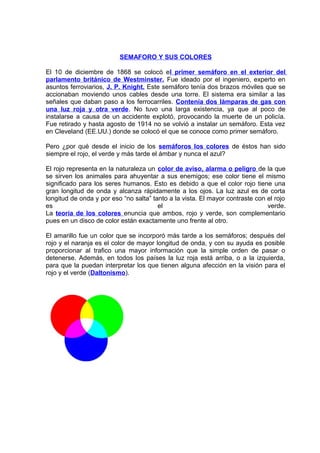Semaforo y sus colores
•Transferir como DOC, PDF•
0 gostou•1,176 visualizações
Definicion
Denunciar
Compartilhar
Denunciar
Compartilhar

Recomendados
Recomendados
Mais conteúdo relacionado
Destaque
Destaque (20)
Product Design Trends in 2024 | Teenage Engineerings

Product Design Trends in 2024 | Teenage Engineerings
How Race, Age and Gender Shape Attitudes Towards Mental Health

How Race, Age and Gender Shape Attitudes Towards Mental Health
AI Trends in Creative Operations 2024 by Artwork Flow.pdf

AI Trends in Creative Operations 2024 by Artwork Flow.pdf
Content Methodology: A Best Practices Report (Webinar)

Content Methodology: A Best Practices Report (Webinar)
How to Prepare For a Successful Job Search for 2024

How to Prepare For a Successful Job Search for 2024
Social Media Marketing Trends 2024 // The Global Indie Insights

Social Media Marketing Trends 2024 // The Global Indie Insights
Trends In Paid Search: Navigating The Digital Landscape In 2024

Trends In Paid Search: Navigating The Digital Landscape In 2024
5 Public speaking tips from TED - Visualized summary

5 Public speaking tips from TED - Visualized summary
Google's Just Not That Into You: Understanding Core Updates & Search Intent

Google's Just Not That Into You: Understanding Core Updates & Search Intent
The six step guide to practical project management

The six step guide to practical project management
Beginners Guide to TikTok for Search - Rachel Pearson - We are Tilt __ Bright...

Beginners Guide to TikTok for Search - Rachel Pearson - We are Tilt __ Bright...
Semaforo y sus colores
- 1. SEMAFORO Y SUS COLORES El 10 de diciembre de 1868 se colocó el primer semáforo en el exterior del parlamento británico de Westminster. Fue ideado por el ingeniero, experto en asuntos ferroviarios, J. P. Knight. Este semáforo tenía dos brazos móviles que se accionaban moviendo unos cables desde una torre. El sistema era similar a las señales que daban paso a los ferrocarriles. Contenía dos lámparas de gas con una luz roja y otra verde. No tuvo una larga existencia, ya que al poco de instalarse a causa de un accidente explotó, provocando la muerte de un policía. Fue retirado y hasta agosto de 1914 no se volvió a instalar un semáforo. Esta vez en Cleveland (EE.UU.) donde se colocó el que se conoce como primer semáforo. Pero ¿por qué desde el inicio de los semáforos los colores de éstos han sido siempre el rojo, el verde y más tarde el ámbar y nunca el azul? El rojo representa en la naturaleza un color de aviso, alarma o peligro de la que se sirven los animales para ahuyentar a sus enemigos; ese color tiene el mismo significado para los seres humanos. Esto es debido a que el color rojo tiene una gran longitud de onda y alcanza rápidamente a los ojos. La luz azul es de corta longitud de onda y por eso “no salta” tanto a la vista. El mayor contraste con el rojo es el verde. La teoría de los colores enuncia que ambos, rojo y verde, son complementario pues en un disco de color están exactamente uno frente al otro. El amarillo fue un color que se incorporó más tarde a los semáforos; después del rojo y el naranja es el color de mayor longitud de onda, y con su ayuda es posible proporcionar al trafico una mayor información que la simple orden de pasar o detenerse. Además, en todos los países la luz roja está arriba, o a la izquierda, para que la puedan interpretar los que tienen alguna afección en la visión para el rojo y el verde (Daltonismo).